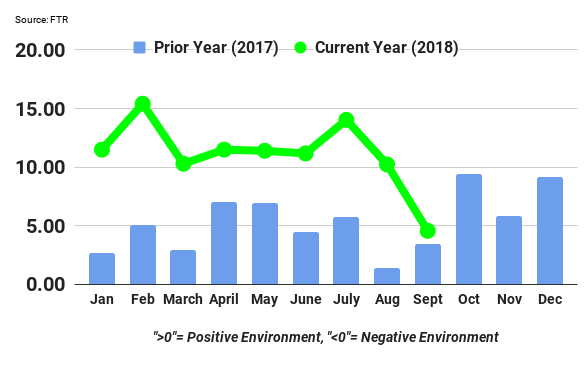Are we finally reaching a period of US freight rate stabilization?
Depends on whom you ask.
Supply Chain Digest Says... |
|
| FT noted that "it is likely that trucking conditions have peaked in the current cycle." |
 |
What do you say? |
| Click here to send us your comments |
 |
| Click here to see reader feedback |
|
|
The Cass Linehaul Index for October, which measures US per mile truckload rates before fuel surcharges and other accessorials, was up another 8.2% year over year. That was down just a bit from the 9.8% rise in rates in September, but still a sizable increase by any measure.
It also the first time the index has been below a 9% increase since April of this year. And it marks the 13th consecutive month the index has risen at least 5% year over year.
"We believe that this is the strongest normalized percentage level of truckload pricing achieved since deregulation ('normalized' meaning except for extreme periods of recovery from recession)," said Donald Broughton, analyst and commentator for the Cass indexes.
In their Q3 earnings calls, most carriers indicated the truckload rate party was hardly winding down yet.
For example, Knight-Swift Transportation, the largest US truckload carrier, said that its revenue per loaded mile – a proxy measure of pricing poweer - was up 19.9% at its core trucking operations in Q3 from a year ago. Revenue at the Knight Trucking segment rose 31%, and operating profit at the unit increased to booming $56.5 million from just $8.6 million in 2017.
Similar story at Covenant Transportation Group, which saw its average revenue per total mile increase 16.4% in Q3.
The booming rate environment also means that carriers are largely able to pass costs of rising driver wages on to shippers.
JB Hunt said in its Q3 earnings report that it increased driver pay a double-digit pace and that it was passing along the higher costs to shippers.
"Trucking costs will likely be up 25% or more versus last year's inflated levels" this fiscal year, said Jon Moeller, CFO at Procter & Gamble, in a recent call with analysts.
But there are some sigNs we may have hit a near peak. First, the comparisons year over year are getting increasingly tough, meaning year-over-year rate hikes at the pace seen in recent months are almost certain to slow before long.
And while the Case Linehaul Index 143.4 in October (versus a baseline 100 in January 2005) marking yet another record all-time high on a nominal basis, and Cass expects more nominal record highs in the coming months, that will come from "slightly lower percentage increases as comparisons grow increasingly tough through February," according to Broughton.
Meanwhile, spot-market trucking rates reached the lowest point of the year in recent weeks, a strong signal rates may even be headed a bit lower.
(See More Below)
|
CATEGORY SPONSOR: SOFTEON |
|
|
| |
|
|
That assessment is supported by the analysts at FTR Associates, who recently said that the firm's Trucking Conditions Index for September fell to the lowest level in a year, at a level of 4.58 (see graphic below).
FTR's Trucking Condition has been Falling, Meaning More Balanced Market Conditions

FTR said this marks the first time the TCI measure has fallen to single digits since December 2017, and is "a reflection of some stabilization in freight rates and demand."
FTR added that "holiday shipping should keep volumes, capacity, and rates healthy," causing the TCI to rise through the end of 2018. However, the index is forecast to begin "a gradual softening through most of 2019."
FT noted that while "A strong economy and labor market should make for a strong fourth quarter heading into a promising 2019," it is likely that trucking conditions have peaked in the current cycle."
That, at last, may be some good news for shippers.
Do you see signs rates are finally toping out? Let us know your thoughts at the Feedback section below.
Your Comments/Feedback
|